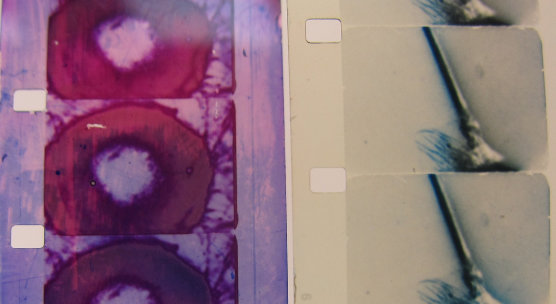‘Seeing through the see-through’ – new exhibition at LifeSpace
Published On Wed 28 Oct 2015 by Grant Hill

The stem cells of fruit flies and the behaviour of slime mould are among the unusual inspirations for work featuring in the newest exhibition at the University of Dundee’s LifeSpace Science Art Research Gallery.
‘Seeing through the see-through’ opens at LifeSpace on Thursday, 29th October and features work created through its first artist-in-residence programme.
Mat Fleming, a filmmaker and artist based in Newcastle, has been travelling to Dundee regularly over the past seven months to undertake a residency funded by the Leverhulme Trust within the prestigious Dundee Imaging Facility at the University’s School of Life Sciences.
Working with varied scientific source material, the artist has reflected on the aesthetic decisions scientists make in the creation of images. The exhibition showcases the work he created during the residency, including film, animations, and printed work, that reflect the transition from film to digital techniques in the area of microscopy.
Sarah Cook, curator of the exhibition at LifeSpace said, “I’m hoping that this exhibition will generate discussion about scientific imaging, about art, and about how we see things differently when we bring artists and scientists together.
“I was very keen for Mat to work with the microscopy unit here in Dundee as his incredibly sensitive and skilled abilities in hand-processing film showcase an aesthetic which is increasingly being lost in our digital age, and allows the reintroduction of some of the magic of image-making.
“It’s not that one is better than the other, but making images on celluloid film and making images with digital data are different qualitative processes, and we easily forget earlier processes when we learn new tools.
“Whilst scientists’ use of imaging technology and the tools of microscopy are a means to an ends in scientific research, they have nevertheless relied on a long history of ingenuity or inventiveness in order to take pictures of that which is mostly invisible because it is at such a tiny scale, the material being looked at is see-through, or because light might kill the sample being examined.
“During his residency Mat has continually embraced this ambiguity and really brought the subjectivity of the artist’s eye to the material he’s been exposed to. He’s been trying to move the conversation away from the usual question, ‘what’s that a picture of?’ to ‘how was that picture made?’”
Digital imaging techniques have hugely changed the field of microscopy from its origins in the 15th century to today. The exhibition looks at a key moment of transition in the field, bringing back to light film and hand-developed photographs, and applying hand drawing techniques to reinterpret digital images.
Working with archival material from the work of Dr Alan Prescott, originally printed on film and glass plate negatives, the artist re-photographed ‘micrographs’ (microscope images) and produced them in black and white prints, and lenticular form – so that numerous images are captured within a single frame and they appear to move as the viewer walks past them.
Dr Sam Swift, director of the Dundee Imaging Facility said, “Imaging and Technology have always been central in our approach to engaging the public and developing inter-disciplinary collaboration.
“Mat’s residency is an exciting example of this. The Dundee Imaging Facility is committed to developing new areas of investigation and engagement at the interface of multiple disciplines: Life Sciences, Physics, Computing and, of course, Art. This is an exciting direction for art and imaging – we were absolutely delighted to host Mat’s residency and are very much looking forward to his exhibition.”
The exhibition also includes objects from the University of Dundee Museum collections which illuminate moments in the history of microscopy, from original slides of samples collected by Professor D’Arcy Thompson, to a View-Master stereoscope from the 1960s that allowed 3D photographs of the inside of a human body to be created.
Editor’s Notes
LifeSpace, the research-driven science art gallery, opened to the public in October 2014 and is a collaborative partnership between researchers from Duncan of Jordanstone College of Art and Design, and the School of Life Sciences. It is open to the public on Saturdays from 11am to 5pm, and is housed within the new Discovery Centre, the latest addition to Dundee’s UK-leading Life Sciences complex. More information can be found at http://lifespace.dundee.ac.uk.
Tours of the exhibition as well as workshops on using microscopes and making images will be held as part of a Life Sciences Open Day on Saturday November 7 from 11am-5pm, as part of Imagine, Explore, Discover – Science at the University of Dundee.
The Leverhulme Trust was established by the Will of William Hesketh Lever, the founder of Lever Brothers. Since 1925 the Trust has provided grants and scholarships for research and education. Today, it is one of the largest all-subject providers of research funding in the UK, distributing approximately £80m a year. For more information about the Trust, please visit www.leverhulme.ac.uk
For media enquiries contact:
Grant Hill
Press Officer
University of Dundee
Nethergate, Dundee, DD1 4HN
Tel: +44 (0)1382 384768
Mobile: 07854 953277
Email: g.hill@dundee.ac.uk